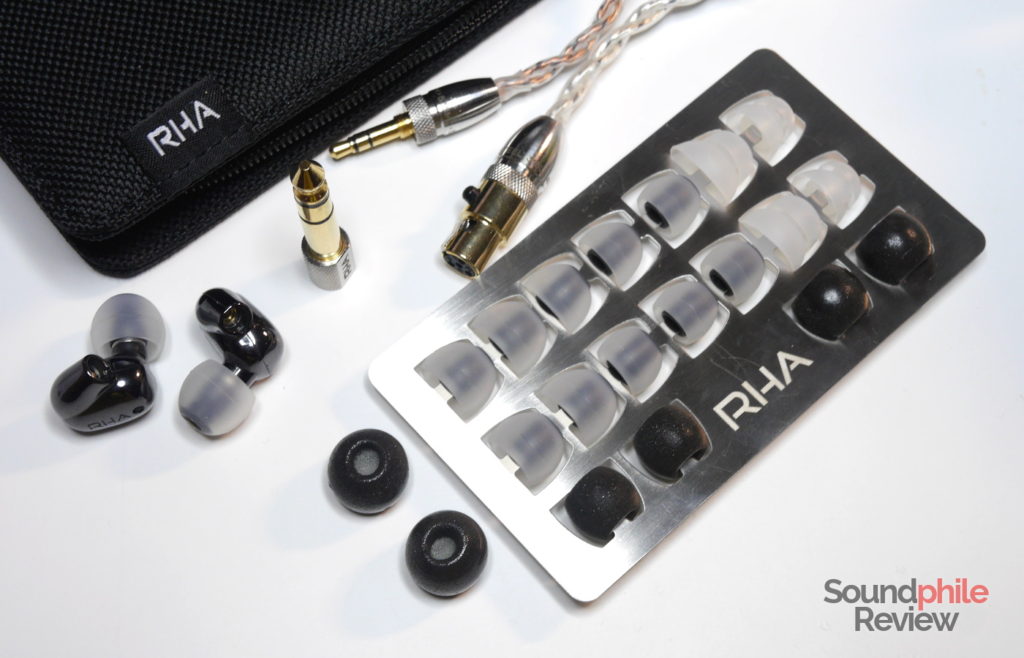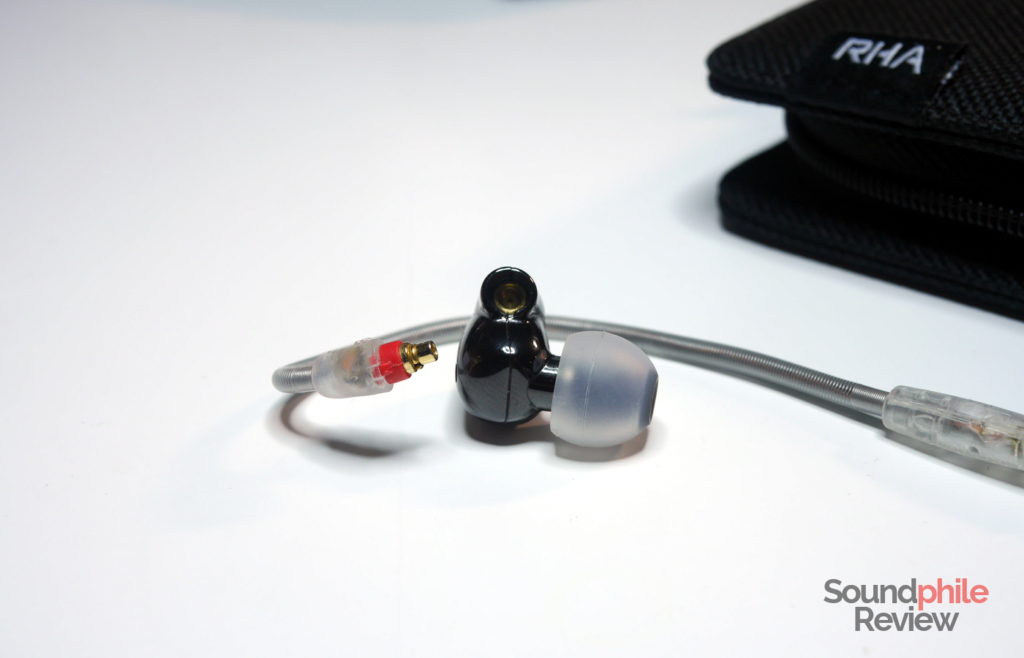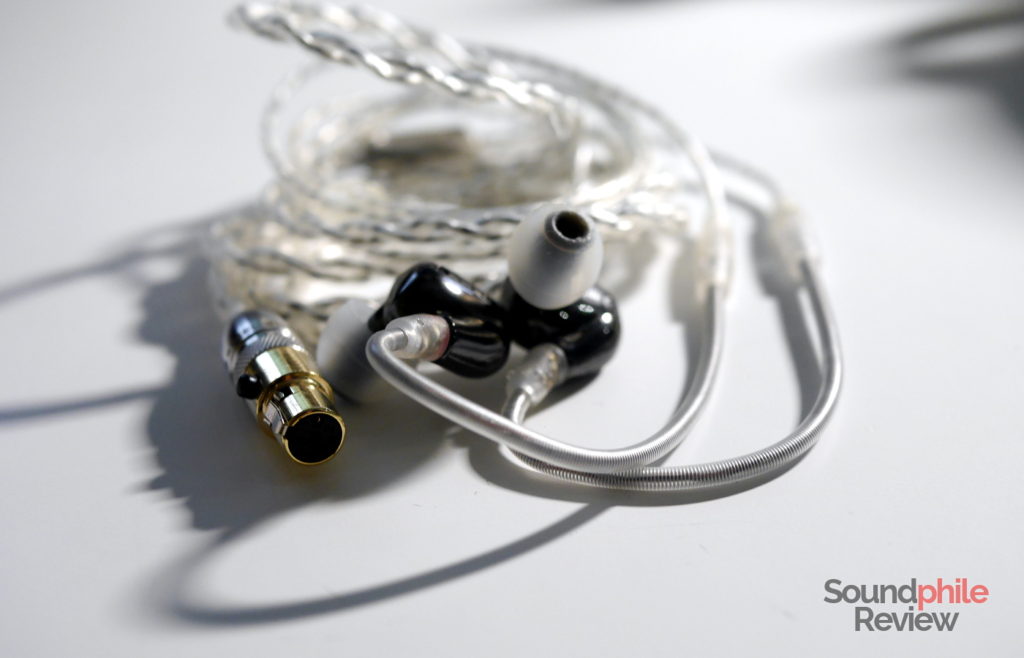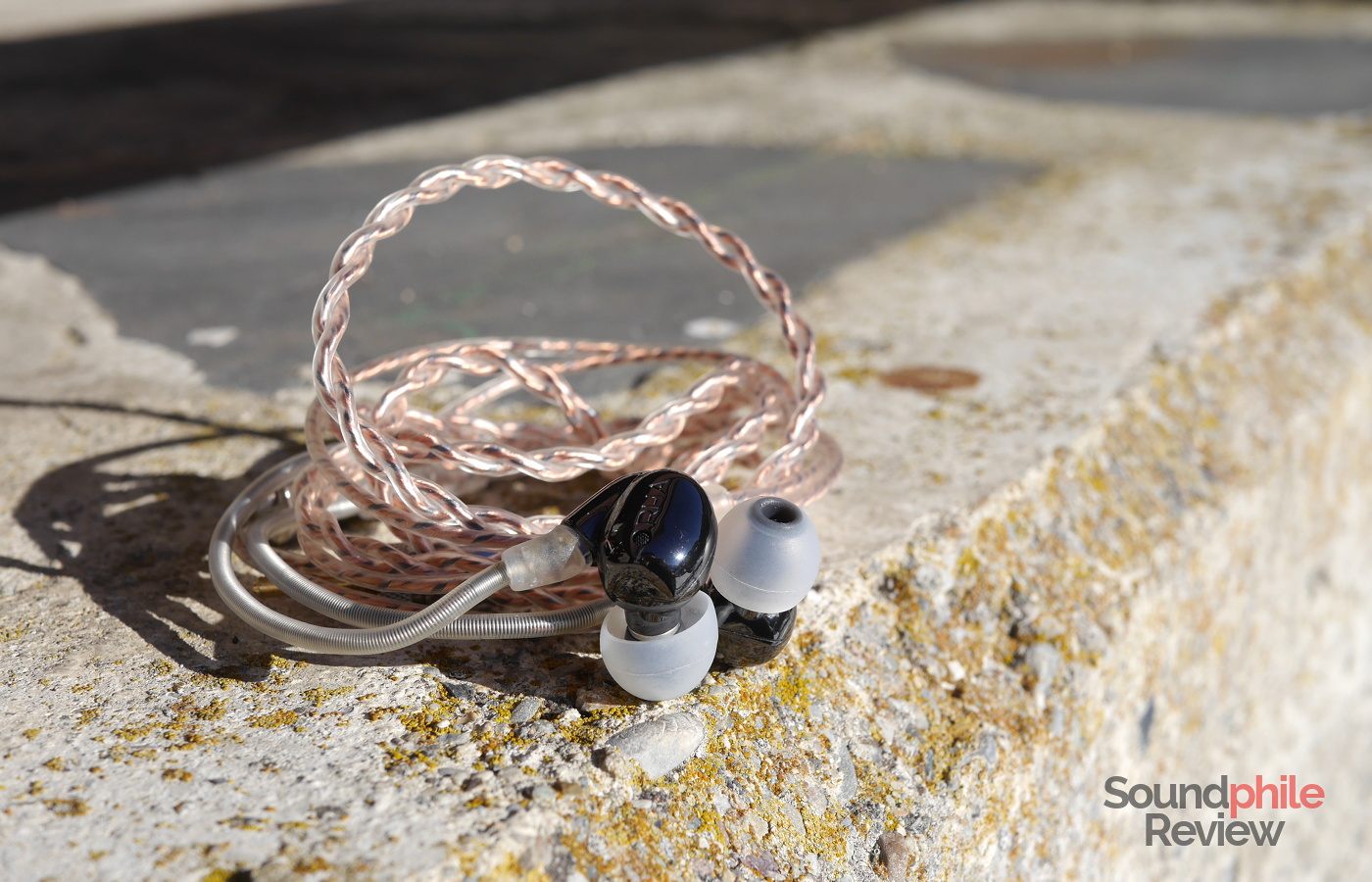RHA’s latest flagship earphones go by the name of RHA CL1 Ceramic. They are part of a new line which uses an all-new dynamic driver (CL driver) for bass and midrange, which is combined with a ceramic plate that takes care of the treble.
The RHA CL1 Ceramic inherits the design principles that inspired the T10 and T20 before them, but it is completely different when it comes to sound. The sound signature can be divisive to say the least; all other aspects are actually improved over the previous generation of flagships and shows how RHA advanced their technical prowess.
Disclaimer: I would like to thank Marina at RHA for lending me this unit, which I sent back. Official specs and other information is available on RHA’s website.
TL;DR: recap
| Pros |
Cons |
| Rock-solid build quality
Fantastic comfort with incredible isolation Removable cable, optional balanced connector Remarkable instrument separation |
Proprietary connector
Treble is piercing, harsh and can feel unnatural Though a flagship, it has extremely coloured sound |
Rating: 8/10
Packaging & Accessories

A comprehensive view of the accessories can be found in the dedicated Out of the Box article. RHA included lots of accessories (as always), though I found a flaw in the hard case being too small for the headphones to fit together with the eartips set. It’s slightly larger than the case included with previous headphones, but the cable takes way more space.
Design & Comfort

I first came in touch with RHA two years ago. They had just launched the T10 in-ear headphones and were on the verge of launching the T20. Their all-metal housing build struck me as it was not only solid, but also beautiful and comfortable. There’s this saying in Italy which goes like squadra che vince non si cambia (you don’t make changes to a winning team) – and RHA did just that, sticking with their previous flagships’ design that proved exceptionally comfortable and attractive, too. The RHA CL1 Ceramic is in fact almost identical to the RHA T20i Black, with a gloss black finish.
RHA used ZrO2 – zircon oxide – for the housings, which should not only be durable and resistant to scratches and the passing of time, but also good at keeping resonance under control. This should ultimately lead to better sound. It has an influence over comfort, too, as it is pretty light.
A striking difference is the absence of filters. While T-series headphones allowed one to select their favourite sound profile by choosing the appropriate filter, the RHA CL1 Ceramic only offers one sound profile – no tuning is possible.

Isolation is excellent and wearing the RHA CL1 Ceramic is akin to wearing ear plugs. It reduces ambient noise to the point it’s barely audible. It is so good that I could listen to Burzum’s Rundtgåing av Den Transcendentale Egenhetens Støtte – an extremely quiet track – with a set of speakers on full blast in the next room without hearing anything outside of the track. It’s the best isolation I have found in a universal IEM.

One big news is the introduction of interchangeable cables. As the headphones come with two different cables, it is possible to select one either to (supposedly) change the sound or to replace a broken cable. Alas, RHA chose the proprietary way when designing the cable connector. They used a modified MMCX, which means you can’t just use any custom cable (i.e. AK Audio 4-core 7N copper cable) to replace the stock one – i.e. if it breaks or if it does not suit your needs. That’s a poor choice in my own view – I love freedom and proprietary standards are freedom’s death.

Cables are soft and malleable, with little to no microphonics; they are both made of intertwined cores individually covered in transparent plastic. They seem fairly resistant and durable; the fact that they’re soft also makes me think that they won’t easily sustain damage from kinks that are born because of everyday usage. One downside is that they are somewhat heavy; it took a bit to get used to it coming from the T20i whose cable is quite light. The 3.5 mm jack has a screw thread on it so that a 6.3 mm adapter can be securely mounted – that’s pretty useful and convenient.
Even when taking the relatively heavy cables into account, comfort is great. The patent-pending ear hooks do a great job at moving the weight away from the ears and placing them on the pinnae. The shape of the housings make them fit nicely in the ears and makes it possible to wear the earphones for hours. The RHA CL1 Ceramic are very comfortable, just as the T-series earphones were before them!
Sound & Specs
My testing setup comprises a Topping DX7 (using both the embedded amplifier and a Head ‘n’ Hifi Objective2), a Little Dot MKIII SE, an RHA Dacamp L1, an Aune M1s, a Cayin N5 ii and an iFi nano iDSD Black Label. I mostly used FLAC files at 16 bit / 44.1 kHz, with random MP3s and high-res files in the mix.
RHA CL1 Ceramic |
| Frequency response | 16 – 45,000 Hz |
| Impedance | 150 Ω |
| Sensitivity | 89 dB |
The high impedance, combined with low sensitivity, means the RHA CL1 Ceramic need an amplifier to sound to their best. A DAP such as the Cayin N5ii is enough for them to play at reasonable volume, but they will only shine when paired to a desktop device (or a portable amplifier with lots of juice).
Though the RHA CL1 Ceramic is the company’s de facto flagship product in the earphone range, it does not follow the market’s trend in offering headphones that are progressively more neutral as the price goes up (though there are notable exceptions, of course). Let’s make this clear right away: these are not neutral, reference tuned headphones. Quite the contrary, in fact: the CL1 Ceramic may well be RHA’s most coloured in-ear headphones to date, with emphasised lows and heavily-coloured treble.
I do not know whether this colouration is caused by the new ceramic driver, or if it was intentional and enabled by the new technology – either way, there is a departure from the general approach the company has maintained. The T20, as an example, was far more balanced, though it had a boost in bass; the RHA MA650a offers an overall balanced (though not perfectly neutral) signature and is a valid product, as long as you can settle for what it offers.
Soundstage is really huge. I did not expect it, as the CL1 Ceramic has a closed back – it is wide and deep, showing great spatial positioning and a sense of space that is uncommon in closed-back headphones. Imaging is also great as it accurately positions the instruments on the soundstage – which is definitely not on par with open-back offerings or earbuds (i.e. Venture Electronics Asura 2.0s), but it renders everything on a wide stage that has multiple layers that remain easily distinguishable.
This leads me to instrument separation, that is even better than that of the RHA T20i, one of my favourites in this regard. It really stands out from the crowd in this regard as you can easily tell each instrument apart from the others, even in the most intense and crowded tracks. This, coupled with the wide soundstage, really brings music to life.
Bass is deep, powerful and beyond neutrality, adding some thump to the music. Though it’s sometimes overshadowed by the treble, it is actually quite strong and offers some heavy colouration to sound. It sounds organic and evenly distributed; there are no significant spikes and this leads to it being easy on the ears. Sub-bass is extended and quite linear, with mid-bass being slightly more accentuated but not excessively so, thus fitting pretty well in the overall context. There’s no overpowering, with transition from mid-bass to lower mids being smooth enough to provide coherent sound. There’s good texturing and detail which hint at good control.
While the transition to mids is smooth, lower mids are severely recessed (in comparison to bass and treble) and this is clearly audible. This unbalance means instruments and voices (especially male voices) appear distant and faint, with a sense of presence that is distorted. This often led me to crave for more volume, though that would make the treble unbearably loud. In Como Lo Veo by Gaia Cuatro the piano is very distant and is difficult to hear at times, when in reality it should be just behind the violin; it has to be noted they are both behind cymbals.
Not only this: the problem with mids is that there’s a strong and sudden spike in correspondence of the higher mids which takes away coherence with the rest. This also makes violins and other high-pitched instruments sharp and sizzling, way more than they should. While there are micro-details all over the place that showcase the driver’s resolution, the downside is the fact that this sharpness is not natural at all.
Treble is definitely the star of the show. Though I like trebly headphones and a bit of added brightness, when I first heard the CL1 I was overwhelmed. Treble on the RHA CL1 Ceramic is just aggressive and spiky, there’s no way around this. It’s incredibly emphasised, especially around the 10 kHz mark, so much that it ends up being harsh and piercing. The problem with this is that highs do not feel coherent to the rest of the sound. Transition between high mids and treble is abrupt, so it lacks that smoothness necessary to have a real natural sound. Treble is so forward in the mix and detailed that it can show micro-details that one should not even hear – as inconceivable as that may be, the purpose of “high fidelity” is to reproduce sound as faithfully to the original as possible, and that’s not the case here.
Now, having this said, does treble sound inherently bad? In my opinion, the answer is no. The thing is, it is super-extended and detailed, and with certain tracks it can be okay to have treble this way. And there’s nothing stopping you to like (or inherently bad in liking) this sound signature. The thing is, it is not faithful to the original nor natural in any way. The CL1 Ceramic is targeting an audience which likes to depart from the usual balanced, aiming-for-neutral-sound music reproduction. From my point of view (and when pursuing sound fidelity), these are no more “audiophile” than my SOL Republic Master Tracks that boost mid-bass to insane levels. That’s totally fine, as long as you know it – the CL1 Ceramic are great to have fun.
Highs can be tamed a bit by the RHA Dacamp L1, though it can only do so much. Even when selecting the lowest treble level available (-3), neutrality is still distant. I could get better results using an equalizer, though it still needs extreme measures such as going down -10 dB in the 10-12 kHz region to feel a bit more balanced.
Given its peculiar sound signature, it is difficult to pinpoint which genres play well with the CL1 Ceramic. As it is basically V-shaped, I would say that it should pair best with modern genres, while being unsuitable for classical, classic rock or jazz. Treble emphasis means certain tracks will sound terrible and it is almost impossible to foresee which categories will do. The best thing is to listen to a track and see how it sounds.
The previously-released RHA T20i, though not sporting a linear frequency response, feel much more balanced and neutral than the CL1 Ceramic. Even though they can sound bright when the “treble” filter is used, they’re still balanced and way more natural. The CL1 Ceramic, on the other side, win on all the technicalities – soundstage, imaging, instrument separation and transient response are all better than on the T20.
Final Thoughts
One of the things that I find difficult in reviewing headphones is trying to be as objective as possible. That’s because audio is inherently subjective – not only is there personal taste that needs to be factored in, but also subjective sensibility to frequencies, different ways the anatomy influences sound and so on. Every single one of us hears things differently – which is really mind blowing, if you think about it. Leaving physical differences aside, taste is a heavy factor in listening – if a product portrays tracks in a way that is unnatural to us, they will more than likely lose appeal. And that’s what happens here – I really want to like the RHA CL1 Ceramic, but I don’t. They’re just too harsh, too focused on treble to be appealing to me.
On the other side, though, I see the CL1 Ceramic as incredibly competent earphones, capable of portraying even the smallest detail and of showing it without leaving anything out of focus. They’re extremely precise and allow you to dissect a track easily. Their soundstage is amazing, given they’re closed-back headphones, and the instrument separation is superb. Technically speaking, RHA achieved remarkable results. When we add comfort, interchangeable cables and materials to the mix, this seems like a clear winner.
Yet, the imbalance in sound is somehow damning. If the RHA CL1 Ceramic were tuned to more neutral a frequency response, they would be incredibly appealing; yet, I think that their tuning caters to a rather small niche. Not only that, but if we consider the fact that headphones (and all audio-related products) should strive for neutrality and natural representation of tunes, then the CL1 Ceramic are as distant from this target as can be.
These are the reasons why I am awarding them with a 8/10. It’s still a good mark, as they’re a solid product, but it’s not as good as it would have been had they been more balanced. Again, that’s to account for the fact that the sound is not natural and not for the fact that it does not suit my taste.
If you can put up with their untamed treble, the CL1 Ceramic have lots to offer from a technical point of view and can reward you with hours of pleasant listening and analytical capabilities. On the other side, their extreme frequency response is really polarising. Given their price, you may want to look at (and listen to) alternatives to see if they appeal to you.
The MSRP for the RHA CL1 Ceramic is $259.99.







Very helpful and insightful review. Thank you.